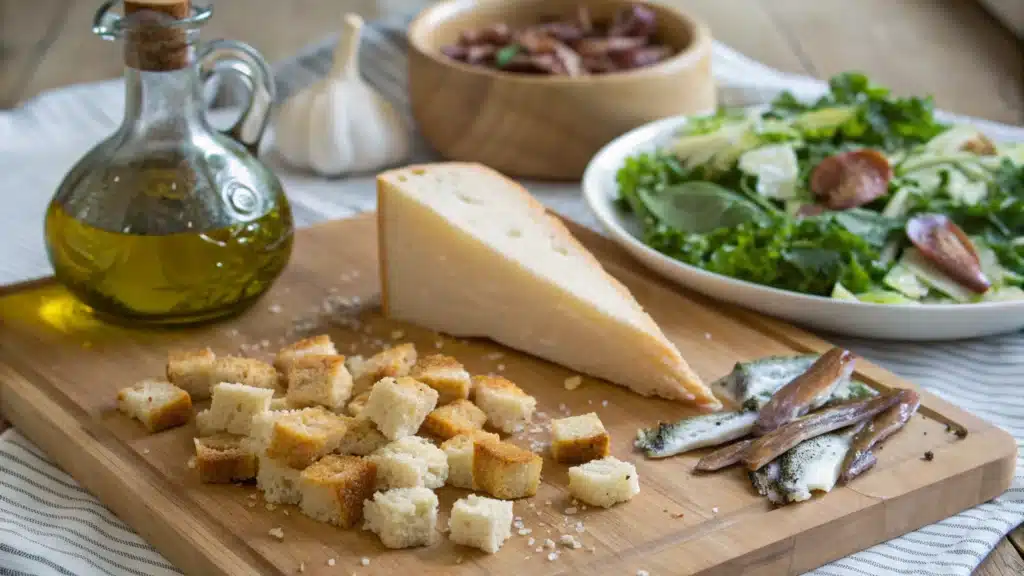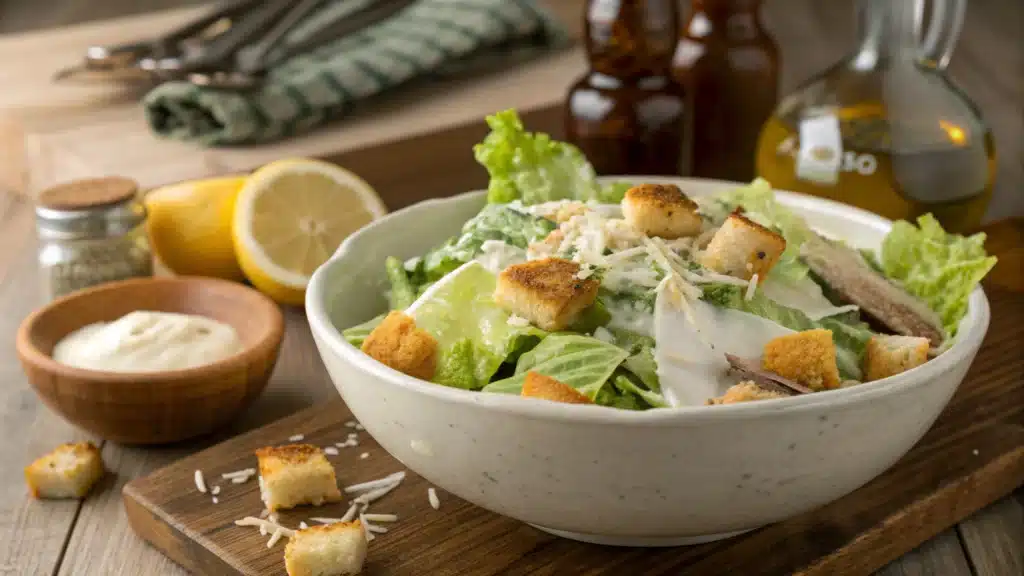Caesar salad is a classic. Caesar salad is an iconic culinarily classic adored for its simplicity, vibrant flavors, and savory texture. What is it that makes the cult dish? Is it the crisp romaine and the creamy dressing or the savory anchovies that distinguish it? This article will go over the history, main ingredients, and delicious versions of Caesar salad, providing you with all the necessary to make your masterpiece at home.
The first step is to look at the humble origins of this famous salad, revealing the key ingredients and the factors that make it so important. From the signature dressing to the crunchy croutons, each component plays a crucial part. We’ll also discuss modern variations and answer questions like “Does real Caesar dressing have anchovies?” We’ll also suggest innovative ways to customize the salad to your liking.
Let’s discover this mystery about what an authentic Caesar salad has and why it’s still a classic favorite.
The Origins of Caesar Salad
Did you know that Caesar salad has a fascinating background that dates back to the 1920s in Mexico? It was developed by a restaurateur from Italy, Caesar Cardini, who whipped up the salad during the Fourth of July frenzied in his kitchen when the ingredients ran low. The result? A simple salad that was so delicious that it quickly became sensational. This improbable creation incorporated only a few ingredients and yet created a sensation for people around the globe.
It was never a simple Caesar salad. It was made up of Romaine salad, croutons of garlic Parmesan cheese, eggs coiled in lemon juice, olive oil, and Worcestershire sauce. The dressing was served at the table, an impressive and exciting display that amazed the guests. While anchovies weren’t in the original recipe, their sour flavor became a signature of the dish as time went on.
Key Features of a Classic Caesar Salad
At its core, the Caesar salad is about balance. Crisp romaine lettuce serves as the base, providing crispness, freshness, and crunch. The homemade croutons add texture, while the nutty, sharp taste of Parmesan cheese brings everything together. The real magic is in the dressing, a smooth, zesty blend that is sweet and tangy.
One of the things that makes this salad distinct is its flexibility. It doesn’t matter if you prefer the salad as an easy appetizer or add seafood or chicken to make something hearty. The Caesar salad can be adapted to fit any event. The bold flavor and easy ingredients make it a regular on menus in restaurants and on dining tables.
When you’re done reading the article, you’ll be aware of the exact ingredients a classic Caesar salad is made of and how you can confidently recreate the classic dish!
Core Ingredients of a Classic Caesar Salad

Romaine Lettuce: The Base of the Salad
The core of the traditional Caesar salad is its Romaine lettuce. The salad is known for its crisp texture and slightly bitter undertone; it is the perfect base. The firm leaves of romaine hold well to the weight of creamy dressing and other toppings, making it a valuable and delicious option. It is important to choose fresh, vibrant green romaine to get the highest-quality outcomes.
To prepare, wash and dry the lettuce thoroughly since excess water may reduce the dressing. To give it a real touch, serve the lettuce with huge, whole leaves rather than cutting the leaves into smaller chunks.
Homemade Croutons: Adding the Crunch
It’s not like a Caesar salad can be completed without the savory crunch of freshly made Croutons. These crispy, golden pieces of bread soak up dressing while also adding texture and depth. Traditional croutons are prepared by toasting cubes of old bread, garlic, olive oil, and, sometimes, herbs like parsley or thyme.
You can use sourdough bread or an authentic baguette to give your dish a bit more flavor. Croutons made from scratch are superior to those bought from a store; they’re fresher, flexible, customizable, and offer a more savory taste. If you’re searching for recipes, look at Flavory Cook’s Chicken Caesar Salad Guide for more ideas.
Parmesan Cheese: Flavor and Texture
Parmesan cheese gives this salad a rich, salty flavor. The authentic Caesar salad uses Parmigiano-Reggiano cheese cut into thin strips. The cheese is a perfect complement to the tangy dressing and provides a smooth texture when it melts against the warm croutons and dressing.
The most important thing to consider when incorporating Parmesan is balance. Too much cheese can make the dish taste bland, and less may cause the salad to lose its characteristic richness. Make sure to add it before serving to preserve its fresh taste and texture.
The Signature Dressing: What Makes it Special?
Key Ingredients of Caesar Dressing
The smooth, sweet Caesar dressing is the main ingredient differentiating this salad from other salads. Made from pantry ingredients, it blends strong flavors into a harmonious mix. The dressing is made up of eggs, olive oil, garlic, lemon juice, Dijon mustard, Worcestershire sauce, and anchovies. Each ingredient contributes to the rich flavor of the dressing.
Egg Yolks: Why They’re Essential
Egg yolks form the basis of the dressing, giving it its velvety texture and rich flavor. Traditional recipes employ cooked or raw eggs, which are emulsified with olive oil to form a smooth consistency. If raw eggs are an issue, pasteurized eggs are an ideal alternative.
Anchovies: The Umami Booster
Whether you love them or not, Anchovies are a must in the traditional Caesar salad. Their briny, salty flavor gives the dressing a rich, savory flavor that turns it from average to outstanding. Anchovy paste is an excellent alternative for those who don’t want to handle whole anchovies.
Lemon Juice: The Brightness Factor
The fresh-squeezed juice of a lemon gives an effervescent tang that adds freshness to the dressing. The acidity of the lemon juice cuts through the richness of other ingredients, resulting in an enticing flavor.
Olive Oil and Worcestershire Sauce: The Balancing Act
Olive oil is the dressing’s base, giving it a rich, fruity flavor that brings everything together. Worcestershire sauce, thanks to the mix of molasses, vinegar, and tamarind, provides subtle flavor and complexity. Together, they achieve the perfect balance between tart, sweet, savory, and sweet.
This dressing forms the foundation of the classic Caesar salad, bringing all of the ingredients together to make an unforgettable and cohesive dish.
Variations and Modern Takes on Caesar Salad
Protein Additions: Chicken, Shrimp, and More
Although the traditional Caesar salad is vegetarian-friendly, modern variations usually include protein, making it an entire meal. Grilled chicken is a popular choice, and its smokey flavor is perfect for the smooth dressing. For those who love seafood, shrimp or even grilled salmon is a delicious addition.
If you’re trying something new at home, Try marinating your shrimp or chicken with garlic and lemon to give it an extra kick. These ingredients can enhance the dish’s taste without obscuring the primary flavors. Look at our Chicken Caesar Salad Guide on Flavory Cook for more protein-rich Caesar recipes.
Vegetarian and Vegan Adaptations
Plant-based diners can enjoy Caesar salad too! By substituting traditional dressing ingredients for vegan alternatives, such as cashew cream in place of egg yolks or nutritional yeast in place of Parmesan, you can recreate the creamy, flavorful essence of the classic dish. Crispy roasted chickpeas are also an excellent replacement for croutons. They provide the protein and crunch.
To boost your salad’s flavor, consider including marinated tempeh, tofu, or roasted vegetables in this salad. These variations preserve what’s essential to the dish while accommodating different dietary preferences.
Spicy or Smoky Twists
Are you looking for a bit of spice? A sprinkle of chili flakes or croutons on your dressing can make your salad delicious. Another option is to use chipotle peppers to create a smoky and spicy dressing. These contemporary versions retain the original flavor of Caesar salad while adding new flavors that appeal to the most adventurous palates.

Common Misconceptions
What Does the Original Caesar Salad Have?
Contrary to popular opinion Contrary to what many believe, the initial Caesar salad didn’t contain anchovies. The flavor was derived from Worcestershire sauce, which has anchovy essence. As time passed, whole anchovies were added to add a more umami-y flavor. The original recipe also had entire romaine leaves and dressing served on the table. It’s rarely seen in kitchens today but is an excellent addition to the dish’s flavor.
Which Ingredient is Not Commonly Found in a Caesar Salad?
Despite its smooth feel, Caesar dressing doesn’t traditionally contain mayonnaise. Many mistakenly believe it is because of its creamy consistency. Instead, the creamy flavor is due to the emulsion of egg yolks and olive oil. Understanding what a classic Caesar salad is made of is crucial.
Does Real Caesar Dressing Have Anchovies?
Yes, authentic Caesar dressing usually contains anchovies; however, they were not in this recipe in the beginning. Your preference determines whether to use whole anchovies, anchovy paste, or Worcestershire sauce. If you want a less fishy flavor, choose the paste, as it blends perfectly in the dressing.
How Do You Make Gordon Ramsay’s Caesar Salad?
Chef Gordon Ramsay adds his signature flavor to Caesar salad by adding a touch of dressing, incorporating Dijon mustard, and making perfectly crisp Croutons. He focuses on fresh, premium ingredients so that every bite is full of taste. His recipe is an expert in balancing the traditional with the new.
For more innovative variations on traditional recipes, peruse Flavory Cook’s recipe library and find ways to spice up your next dinner.
If you know the origins and variations of this classic dish, you’ll never be able to ask what’s in a classic Caesar salad!
FAQs
What is the Best Way to Store Caesar Salad Dressing?
Homemade Caesar dressing is best stored in a sealed, airtight container in the refrigerator. It can be kept fresh for up to three days, but it’s ideal to use it as quickly as possible to get the best flavor. Since the dressing is comprised of egg yolks, keeping it cool is vital to ensure its freshness and safety.
Can You Make Caesar Salad Ahead of Time?
Yes, but be careful. Make the elements—croutons, romaine, and dressing—separately, then assemble the ingredients before serving. This stops the lettuce from becoming spongy and helps keep the croutons crunchy. If you prepare ahead, you’ll be able to save time and ensure that each bite is delicious and fresh.
How to Serve Caesar Salad Perfectly?
Serve Caesar salad on chilled plates to keep it fresh. Sprinkle the salad with the dressing before serving, making sure there is an even coating. Top with croutons or Parmesan cheese for a stunning display.
What are the Most Popular Caesar Salad Pairings?
Caesar salad goes well with grilled chicken, roast chicken meat, or rich soup. These flavors make a balanced and satisfying meal, making the salad’s rich flavors more appealing with different flavors and proteins.
Conclusion
Why Caesar Salad Endures as a Classic
Caesar salad remains a popular dish around the world because of its flawless blend of elegance and simplicity. The bold flavors, crunchy textures, and creamy dressing create an unbeatable harmony that is hard to beat. Whether served as a starter or a main course, this recipe can be adjusted to many occasions while remaining true to its origins.
Tips for Making the Best Caesar Salad at Home
Making the best Caesar salad from scratch begins with the freshest, highest-quality ingredients. Every ingredient plays an important part, from fresh romaine to the sour flavor of anchovies. Don’t be stingy with homemade croutons, which can dramatically elevate your dish. Explore different combinations but ensure that the essence remains.
Once you’ve figured out the essential ingredients of an authentic Caesar salad and how it’s prepared, you’re ready to enjoy this classic dish regardless of whether you’re following tradition or giving it your own flavor!
Caesar Salad: A Nutritional Perspective
Nutritional Value of a Classic Caesar Salad
If you ask what the traditional Caesar salad consists of, many are wondering how its ingredients can contribute to nutrition. The classic Caesar salad, featuring its mixture of romaine lettuce, Parmesan cheese, croutons, and a creamy dressing, creates a balance between pleasure and nutrition. Romaine lettuce is not high in calories yet is high in vital vitamins such as A, C, A, and K. It also has dietary fiber that aids in digestion.
Although the dressing is calorie-dense because of its egg yolk and olive oil base, it contains nutritious fats and protein. Parmesan cheese is rich in calcium and has an umami taste; however, because of its sodium content, it is best enjoyed in moderation. Croutons, depending on how they’re prepared, may add calories and fat, particularly when they’re toasted with oil or butter.
Adjusting Caesar Salad for Dietary Needs
For those who want a healthier alternative to the salad, a few tweaks can make a significant impact. Change the traditional croutons to whole grain alternatives or roast chickpeas. Reduce the amount of dressing by reducing the amount of oil and substituting Greek yogurt in place of some of the egg yolk or olive oil. These modifications preserve the original flavor of the dish and reduce energy and calories.
Adding protein, such as shrimp or grilled chicken, will make the salad more nutritious and help balance its nutritional profile. These modifications allow the salad to be adapted to diverse dietary needs, ranging from low-calorie meals to protein-rich plans.
Elevating Your Caesar Salad Experience

Presentation Tips for the Perfect Caesar Salad
The presentation is crucial to making your Caesar salad seem special. Serve your salad in a large, shallow bowl that showcases the crisp layers of romaine, golden croutons, and a creamy dressing. Cut Parmesan cheese into thin ribbons and sprinkle them on top for a more elegant appearance.
Think about serving the dressing as a side dish, allowing guests to mix it in according to their preference. This keeps the salad in good condition but can also allow for personalization, especially for those who like less dressing.
Creative Add-Ons for a Gourmet Twist
Want to elevate your Caesar salad game? Try gourmet toppings such as roasting garlic, candied nuts, or truffle oil. Adding seasonal ingredients such as roasting squash in the fall or fresh berries in summer produces a distinct flavor profile that is a perfect match for the base recipe.
To get a boost of protein, Consider grilling seafood, seared fish, or even poached eggs. These options transform the salad from a basic salad to a worthy restaurant dish. Designing your salad with care will highlight the elements that make this classic so adaptable but keep the core.
Now that you know what a traditional Caesar salad consists of and how you can adapt it to your own personal taste, you’re able to create the perfect version that matches your tastes and impresses guests!


1 thought on “What Does a Classic Caesar Salad Contain?”